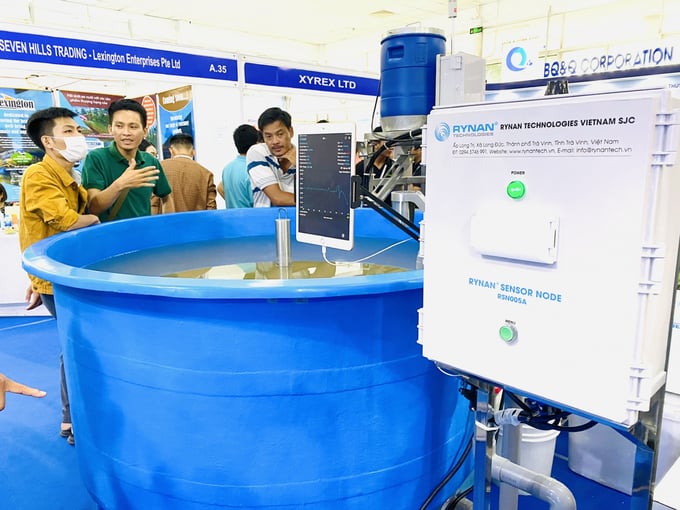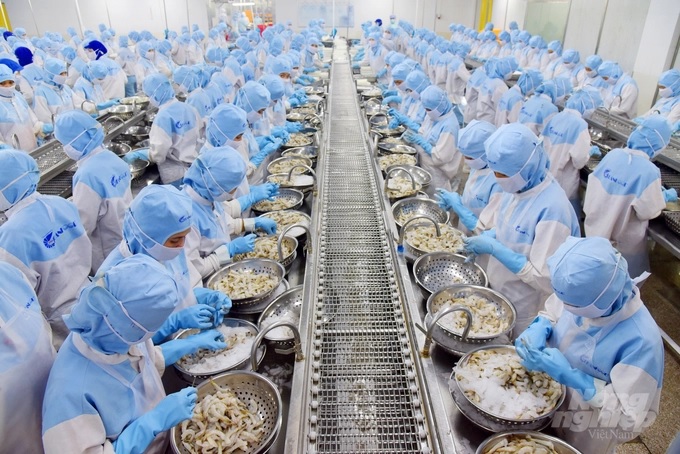November 22, 2025 | 14:10 GMT +7
November 22, 2025 | 14:10 GMT +7
Hotline: 0913.378.918
November 22, 2025 | 14:10 GMT +7
Hotline: 0913.378.918

The shrimp industry plays an important role in Vietnam's seafood exports in the past five decades. Photo: Le Hoang Vu.
The shrimp industry has played an important role in Vietnam's seafood exports during the past five decades. The shrimp industry annually contributes 45-50% of the total seafood export value. With continuous efforts, Vietnam has become a leading shrimp supplier with export value accounting for 13-14% of the global shrimp export value.
In recent years, Vietnam's shrimp industry has had many innovations and developments. Many households and businesses have increased the application of new technologies to shrimp farming as a way to improve production efficiency and adapt to climate changes. However, Vietnam's shrimp production efficiency and competitiveness still have certain limitations and the shrimp industry faces many difficulties. For Vietnamese shrimp to increase its competitiveness in the market, it is necessary to improve the value chain.
Providing insight on the shrimp market in 2023, Mr. Truong Dinh Hoe, General Secretary of the Vietnam Association of Seafood Exporters and Producers (VASEP), said, "It is difficult to make predictions about shrimp export results due to the impact of inflation. Market demand is decreasing and competition is increasing wworldwide".
Mr. Hoe suggested businesses optimize production costs, diversify markets and products to meet market requirements. "We need to pay more attention to specific products and value-added products and proactively change market and product structures to suit the needs of each segment".
Regarding the costs of farmed shrimp, Mr. Le Van Quang, Chairman of the Board of Directors of Minh Phu Seafood Corporation, suggested reconsidering the approach from the seed stage to the model, process, or process stocking density.
Accordingly, it is necessary to promote the domestication program of broodstock to create disease-resistant seed sources, adapt to the conditions of the farming areas, improve the success rate of farming and develop optimal farming process for each shrimp farming model.

The Tomgoxy model of super intensive farming of white-leg shrimp with no greenhouse gas emissions of My Lan Group. Photo: Le Hoang Vu.
According to experts, the success rate of shrimp farming in Vietnam is still low. Input costs are high, and disease outbreaks are still common, leading to the cost of farmed shrimp being USD 1-2/kg higher than the two main competitors, Ecuador and India. These exisitng issue greatly affect the competitiveness of Vietnamese shrimp in the world market.
The shrimp industry therefore needs to change its approach, including breeding, models, and farming processes. The goal is to increase the success rate of farming, reduce production costs, and help Vietnam's shrimp industry maintain and promote its position in the world market.
Mr. Nguyen Cong Can, Deputy Chief Technical Officer of Viet Uc Seafood Corporation, said that the cross-cutting goal initiated by the business is to spread a closed value chain solution for a sustainable high-tech shrimp industry. "The term 'sustainability' here should be understood as 'sustainable for the environment, the shrimp industry and consumers'. it should also elevate the value of the Vietnamese shrimp brand".

Vietnam's shrimp industry needs new approaches, from the seed stage to the model and production process. Photo: Le Hoang Vu.
According to Dr. Nguyen Thanh My, Chairman of Mylan Group (Tra Vinh), Mylan's super-intensive farming of white leg shrimp without greenhouse gas emissions has brought great successes. "Although this is a very new farming method for shrimp farmers across the country, with the results drawn from actual production on farms in Tra Vinh, the model has convinced even the country's leading scientists in the field of shrimp farming".
According to VASEP, Vietnam's shrimp exports in 2022 reached a record USD 4.3 billion, up 11% compared to 2021. This was also the first year shrimp exports surpassed USD 4 billion.
Despite a sharp decrease (down 23% compared to 2021), the USA was still the largest market for Vietnamese shrimp with an export turnover of USD 807 million, followed by EU with USD 691 million, Japan: USD 671 million, China - Hong Kong: USD 664 million, Korea: USD 468 million, Australia: USD 272 million.
Regarding the structure of export products, in the past year, the value of processed shrimp products experience a better increase rate than fresh/frozen shrimp products. Processed black tiger shrimp increased by 15%, processed white-leg shrimp increased by 11%, shrimps increased by 11%, fresh/frozen white leg shrimp increased by 3%. While white-leg shrimp exports continued to grow, black tiger shrimp exports suffered a slight decrease.
Translated by Ha Phuc
/2025/11/21/4309-2-153400_128.jpg)
(VAN) Green and low-emission rice is paving the way for Vietnamese rice to enter high-end markets, marking the beginning of a transformation journey toward greening and elevating the national rice brand.

(VAN) ‘Right to Win’ outlines a national action plan that shapes a new vision for Viet Nam’s agriculture in an era of renewal and global integration.

(VAN) Lam Dong’s farmed sturgeon output this year is expected to reach 2,300 tons, worth VND 450 billion, affirming the brand’s position on the market.

(VAN) A surge in Ukrainian egg exports, largely driven by soaring sales to the UK over the last few years, has notably pushed up egg prices on the domestic market.

(VAN) The price of Arabica Catimor coffee in Quang Tri is currently at VND 25,000–27,000/kg (fresh cherries), the highest level ever recorded

(VAN) 'From the coffee story, we can think deeper and further about the crop production sector - from development orientations and value-chain organization to international integration,' assessed Dr Le Quoc Doanh.
/2025/11/18/2431-0-161627_248.jpg)
(VAN) Viet Nam accounts for 43% of the world's export volume of Robusta coffee. However, the Vietnamese Robusta coffee brand has yet to gain broad recognition on the global market.